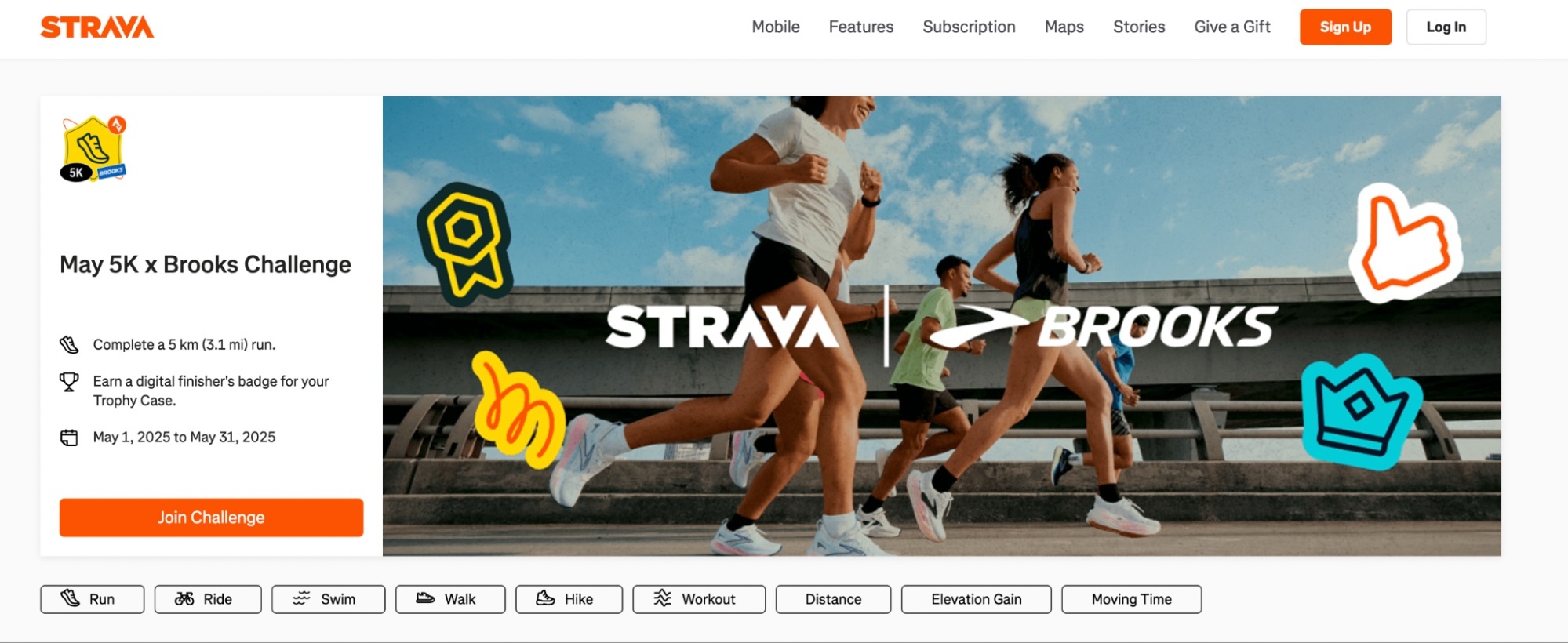 Logo
Logo
EXPERT INSIGHTS
May-28-2025
What is gamification marketing and 6 examples from top brands
Khoros staff
Gamification marketing is the practice of applying game-like elements — such as points, badges, leaderboards, and challenges — to brand experiences in order to capture attention, inspire participation, and build lasting brand loyalty. It transforms routine interactions into rewarding moments that motivate people to engage more deeply and frequently with your brand.
In this guide, we’ll walk you through the fundamentals of gamification marketing, explain why it’s so effective, and share standout examples from brands that are doing it right. Whether you're just getting started or looking to elevate your current strategy, this blog has everything you need to build fun, purposeful, and high-impact customer experiences.
What is gamification marketing?
As briefly mentioned, gamification marketing is the strategic use of game mechanics, such as points, badges, leaderboards, challenges, and rewards, to engage and motivate customers. By tapping into intrinsic human drives — like the need for achievement, recognition, status, and competition — gamification makes engagement feel personal and meaningful. When customers are rewarded for actions like, for example, writing a review, completing a purchase, or answering a peer’s question, they’re not just participating; they’re building investment in the community and the brand. And they have fun doing it.
Key elements of gamification marketing
Effective gamification marketing relies on simple, intuitive mechanics that encourage users to take action and keep coming back. These elements transform routine interactions into rewarding experiences that drive loyalty and participation. Here are some essential elements:
Points and rewards. Points give users a tangible way to measure their progress — whether it’s dollars spent, posts made, or challenges completed. When paired with meaningful rewards like discounts, exclusive content, or VIP access, points become a powerful motivator that reinforces positive behaviors and encourages repeat engagement.
Badges and achievements. Badges recognize milestones and highlight user contributions, turning participation into a visible symbol of accomplishment. These markers of status not only motivate continued activity, but also act as social proof — signaling credibility, loyalty, and expertise to the broader community.
Leaderboards. Leaderboards introduce healthy competition by ranking users based on activity, accuracy, or influence. They appeal to users’ desire for recognition and help surface top contributors, driving engagement while building a culture of visibility and excellence.
Challenges and quests. Time-bound challenges prompt users to complete specific actions — like posting a review, joining a conversation, or inviting peers. These limited-time missions add urgency and variety, while also creating opportunities for shared goals that foster a sense of community. Challenges can also foster a sense of community when participants rally around a common goal.
Progress bars and streaks. Progress bars offer instant visual feedback, showing users exactly how close they are to reaching the next level, unlocking a reward, or completing a task. Streaks — earned through consecutive days of activity — are especially effective: once established, they tap into loss aversion, making users more likely to return so they don’t “break the chain.”
Benefits of gamification marketing
When done right, gamification marketing delivers measurable wins across customer engagement, loyalty, and data collection, while making the customer experience more enjoyable.
Improve customer loyalty
Gamification creates meaningful, repeatable touchpoints that build emotional connections with your brand. By rewarding ongoing participation, you foster a sense of belonging that keeps customers coming back, transforming casual users into devoted fans.
Increase conversion rates
Adding game mechanics to marketing campaigns, like the limited-time challenges or progress-based rewards mentioned above, can motivate users to take immediate action. This playful nudge often results in higher click-throughs, faster sales cycles, and improved campaign performance.
Boost user engagement
Gamification gives customers a reason to spend more time with your brand. Whether they’re completing a challenge, checking their leaderboard rank, or unlocking a badge, users are encouraged to interact more frequently and deeply with your content.
Gather insights about your customers
Each gamified interaction provides valuable behavioral data like what customers engage with, how often, and what motivates them. These customer insights allow you to refine your marketing strategy, personalize offers, and better anticipate customer needs.
What makes gamification marketing so effective?
Gamification is powerful because it speaks to something deeply human — the desire for purpose, progress, and recognition. When customers earn a badge, complete a challenge, or climb a leaderboard, they’re not just engaging with your brand — they’re achieving something. This sense of accomplishment drives sustained engagement and builds emotional connection.
According to gamification expert Betty Adamou, game-based experiences succeed when they meet four key psychological needs: relatedness, autonomy, mastery, and purpose (RAMP). That’s why the most effective gamification strategies include goals, feedback, rewards, and opportunities for choice — elements that meet these needs by making people feel invested and in control.
Gamification also keeps brand experiences fresh and dynamic. Limited-time challenges, evolving reward tiers, and interactive campaigns create a rhythm that brings people back. One report found that companies using gamified strategies saw a 22% increase in customer retention and a 48% boost in engagement. When something is fun and interactive, customers are more likely to remember it and return.
Beyond driving engagement, gamification is a feedback engine. Every interaction — completing a task, unlocking a reward, leveling up — creates data marketers can use to personalize future campaigns and uncover new engagement opportunities. Done well, gamification transforms passive customers into active participants. And the impact is real: 89% of loyalty platform users say that rewards available influenced their decision to renew a subscription and remain a customer. Gamification helps deliver those experiences at scale — reinforcing trust, strengthening connection, and turning engagement into lasting brand advocacy.
Examples of gamification marketing from top brands
Gamification is a proven strategy across industries — from retail to fitness to tech — and top brands are using it to strengthen loyalty and drive results. Here are a few standout gamification marketing examples.
1. Cisco’s online community

Cisco’s global support community uses gamification extensively to encourage peer-to-peer help and knowledge sharing. Members earn points, badges, and ranks by posting answers, marking solutions, and participating in discussions. Leaderboards spotlight top contributors, and special recognition (like “Spotlight Awards”) further motivates sustained participation. This gamification strategy has helped Cisco build one of the largest and most active technical communities in the world.
2. Sephora’s insider program

Sephora’s Beauty Insider program is a standout example of gamification driving customer loyalty in retail. Members earn points with every purchase, which can be redeemed for exclusive products, samples, and beauty experiences. The program’s tiered structure — Insider, VIB, and Rouge — encourages repeat purchases by unlocking progressively more valuable perks at each level. Seasonal savings events, birthday gifts, and limited-time challenges keep the experience dynamic, motivating customers to stay engaged and increase their spending to reach the next tier.
3. Duolingo’s language app

Duolingo has become a global leader in online education by making language learning feel like a game. Through daily streaks, XP points, badges, and leaderboards, the app keeps users motivated and accountable — turning what could feel like a chore into a rewarding habit. Each lesson is structured as a quick, interactive minigame, from matching words to translating audio clips and practicing pronunciation. Combined with its playful mascot and constant progress tracking, Duolingo demonstrates how gamification can drive long-term engagement and transform complex learning into rewarding leisure.
4. Zoom’s online community

Zoom leverages gamification in its online community to drive engagement, recognize contributions, and foster peer-to-peer support. Through its “Happy Rewards” program, members earn points by answering questions, sharing solutions, and participating in discussions. Weekly leaderboards highlight top contributors, and special badges offer visible recognition for active and helpful users. These elements create a friendly, competitive environment that motivates continued participation. By integrating gamification into its community strategy, Zoom not only improves the customer support experience but also builds stronger brand loyalty through meaningful recognition and interaction.
5. Starbuck’s loyalty program

Starbucks Rewards turns everyday purchases into an engaging game of points, perks, and progress. Through the mobile app, customers earn “Stars” for every transaction, which can be redeemed for free drinks, food, or exclusive merchandise. The program features tiered levels — Green and Gold — motivating members to keep earning to unlock premium benefits. Limited-time challenges, bonus star promotions, and seasonal campaigns add fresh incentives, keeping customers actively engaged and encouraging repeat visits.
6. Strava’s fitness challenges

Strava turns everyday workouts into a social, achievement-driven experience by hosting online challenges for people to participate in. Users earn digital trophies, personal records, and “Kudos” from peers for completing rides, runs, and challenges. Monthly leaderboards and milestone badges foster healthy competition and consistency. By transforming fitness into a dynamic, community-powered game, Strava builds a loyal, motivated user base that returns to track progress, connect with others, and push their limits.
Incorporate gamification into your strategy with a Khoros Community
Ready to tap into the power of gamification? With Khoros Communities, it’s simple to build an interactive, rewarding customer space that keeps people coming back. Our built-in gamification features — like badges, ranks, leaderboards, and challenges — help brands increase engagement, strengthen loyalty, and create a dynamic environment where customers can connect, contribute, and grow.
Let’s transform your engagement strategy.Get a demo of Khoros Communities today.












